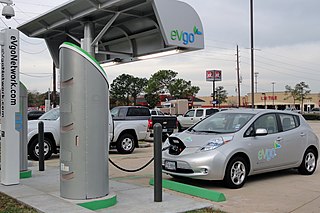Related Research Articles

An electric vehicle (EV) is a vehicle that uses one or more electric motors for propulsion. It can be powered by a collector system, with electricity from extravehicular sources, or it can be powered autonomously by a battery. EVs include but are not limited to road and rail vehicles, and broadly can also include electric boat and underwater vessels, electric aircraft and electric spacecraft.
Hybrid Synergy Drive (HSD), also known as Toyota Hybrid System II, is the brand name of Toyota Motor Corporation for the hybrid car drive train technology used in vehicles with the Toyota and Lexus marques. First introduced on the Prius, the technology is an option on several other Toyota and Lexus vehicles and has been adapted for the electric drive system of the hydrogen-powered Mirai, and for a plug-in hybrid version of the Prius. Previously, Toyota also licensed its HSD technology to Nissan for use in its Nissan Altima Hybrid. Its parts supplier Aisin Seiki Co. offers similar hybrid transmissions to other car companies.

A plug-in hybrid electric vehicle (PHEV) is a hybrid electric vehicle whose battery pack can be recharged by plugging a charging cable into an external electric power source, in addition to internally by its on-board internal combustion engine-powered generator. Most PHEVs are passenger cars, but there are also PHEV versions of sports cars, commercial vehicles, vans, utility trucks, buses, trains, motorcycles, mopeds, military vehicles and boats.

Vehicle-to-grid (V2G), also known as Vehicle-to-home (V2H), describes a system in which plug-in electric vehicles (PEV) sell demand response services to the grid. Demand services are either delivering electricity or reducing their charging rate. Demand services reduce pressure on the grid, which might otherwise experience disruption from load variations. Vehicle-to-load (V2L) and Vehicle-to-vehicle (V2V) are related, but the AC phase is not sychronised with the grid, so the power is only available to an "off grid" load.
Blended mode is a charge-depleting mode of operation for plug-in hybrid electric vehicles (PHEVs) in which most of the motive energy is supplied by the battery pack but supplemented by the internal combustion engine (ICE). In contrast, all-electric or battery electric vehicles use only the electricity provided by the battery pack as their sole source of energy in a charge-depleting manner. Both types of advanced technology vehicles use regenerative brakes to recapture kinetic energy that should not be considered a fuel source but rather an efficiency aspect of these types of electric vehicle powertrains not found in traditional internal combustion engine vehicles.
Hybrid vehicle drivetrains transmit power to the driving wheels for hybrid vehicles. A hybrid vehicle has multiple forms of motive power.

The Hokie Electric Vehicle Team of Virginia Tech, better known as HEVT, is a nationally recognized undergraduate student design team in the Department of Mechanical Engineering at Virginia Tech. HEVT was formed in 1994 to compete in the 1995 Hybrid Electric Vehicle (HEV) Challenge, one of the many competitions organized by the Argonne National Laboratory through the United States Department of Energy. HEVT has been involved in the Department of Energy Advanced Vehicle Technology Competitions (AVTCs) ever since. HEVT attributes a significant amount of its success to their Advisor, Professor Doug Nelson in Mechanical Engineering. Dr. Nelson has received the Outstanding Faculty Advisor award at competition 3 times. He has greatly aided the education of students at Virginia Tech and helped the team succeed at competition The overall highlights of past competitions are as follows:

The Chevrolet Volt is a plug-in hybrid car manufactured by General Motors, also marketed in rebadged variants as the Holden Volt in Australia and New Zealand and the Buick Velite 5 in China, and with a different fascia as the Vauxhall Ampera in the United Kingdom and as the Opel Ampera in the remainder of Europe. Volt production ended in February 2019.
All-electric range (AER) is the maximum driving range of an electric vehicle using only power from its on-board battery pack to traverse a given driving cycle. In the case of a Battery electric vehicle (BEV), it means the maximum range per recharge, typically between 150 and 400 miles. For a plug-in hybrid electric vehicle (PHEV), it means the maximum range in charge-depleting mode, typically between 20 and 40 miles. PHEVs can travel considerably further in charge-sustaining mode which utilizes both fuel combustion and the on-board battery pack like a conventional hybrid electric vehicle (HEV).
Voltec, formerly known as E-Flex, is a General Motors powertrain released in November 2010. The Voltec architecture is primarily a plug-in capable, battery-dominant electric vehicle with additional fossil fuel powered series and parallel hybrid capabilities.

The Elect'Road is a plug-in series hybrid version of Renault's popular Kangoo. Sales began in Europe in 2003, mainly in France, Norway and a few in the UK. The Elect'Road was sold alongside Renault's Electri'cité electric-drive Kangoo battery electric van. Renault discontinued the Elect'Road after selling about 500, primarily in France, Norway and the UK, for about €25,000.

An electric vehicle battery is a rechargeable battery used to power the electric motors of a battery electric vehicle (BEV) or hybrid electric vehicle (HEV).

A battery electric vehicle (BEV), pure electric vehicle, only-electric vehicle, fully electric vehicle or all-electric vehicle is a type of electric vehicle (EV) that exclusively uses chemical energy stored in rechargeable battery packs, with no secondary source of propulsion. BEVs use electric motors and motor controllers instead of internal combustion engines (ICEs) for propulsion. They derive all power from battery packs and thus have no internal combustion engine, fuel cell, or fuel tank. BEVs include – but are not limited to – motorcycles, bicycles, scooters, skateboards, railcars, watercraft, forklifts, buses, trucks, and cars.

A plug-in electric vehicle (PEV) is any road vehicle that can utilize an external source of electricity to store electrical energy within its onboard rechargeable battery packs, to power an electric motor and help propelling the wheels. PEV is a subset of electric vehicles, and includes all-electric/battery electric vehicles (BEVs) and plug-in hybrid electric vehicles (PHEVs). Sales of the first series production plug-in electric vehicles began in December 2008 with the introduction of the plug-in hybrid BYD F3DM, and then with the all-electric Mitsubishi i-MiEV in July 2009, but global retail sales only gained traction after the introduction of the mass production all-electric Nissan Leaf and the plug-in hybrid Chevrolet Volt in December 2010.

The adoption of plug-in electric vehicles in the United States is supported by the American federal government, and several states and local governments. As of December 2021, cumulative sales in the U.S. totaled 2.32 million highway legal plug-in electric cars since 2010, led by all-electric cars. The American stock represented 20% of the global plug-in car fleet in use by the end of 2019, and the U.S. had the world's third largest stock of plug-in passenger cars after China (47%) and Europe (25%).

The Toyota Prius Plug-in Hybrid is a plug-in hybrid liftback manufactured by Toyota. The first-generation model was produced from 2012 to 2016. The second-generation model has been produced since 2016. Production of the third-generation model began in 2023.

A range extender is a fuel-based auxiliary power unit (APU) that extends the range of a battery electric vehicle by driving an electric generator that charges the vehicle's battery. This arrangement is known as a series hybrid drivetrain. The most commonly used range extenders are internal combustion engines, but fuel-cells or other engine types can be used.

Range anxiety is the driver's fear that a vehicle has insufficient energy storage to cover the road distance needed to reach its intended destination, and would thus strand the vehicle's occupants mid-way. The term, which is now primarily used in reference to the practical driving range of battery electric vehicles (BEVs), is considered to be one of the major psychological barriers to large-scale public adoption of electric cars.
The University of Kansas Sustainable Automotive Energy Infrastructure Initiative, or more commonly referred to as the KU Ecohawks is an ongoing project that works to promote sustainability in the automotive sector. Founded during the beginning of the Automotive industry crisis of 2008–2010 in the U.S., the group recycles old vehicles to run on community wastes and renewables, especially on the University of Kansas campus and not rely on conventional fossil fuel sources that pollute the local and global environment.
There are numerous versions of vehicle propulsion systems. Many of those came into fruition due to need for cleaner vehicles. Each of them might have many abbreviations and some might be misleading. This article explains shortly what defines them.
References
- ↑ "Battery Requirements for Plug-In Hybrid Electric Vehicles - Analysis and Rationale" (PDF). National Renewable Energy Laboratory. December 2007. Archived from the original (PDF) on 2016-03-07.